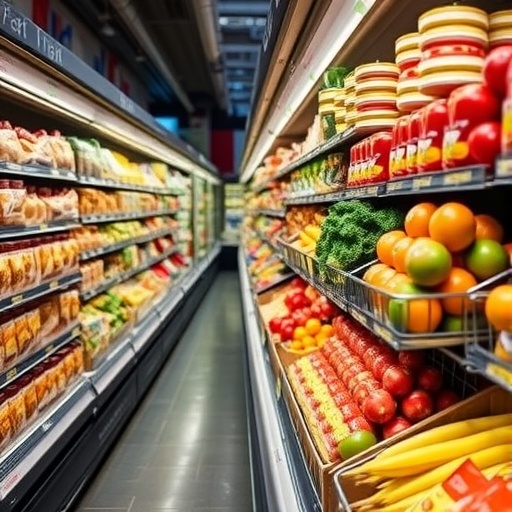Confusing food labels have long hindered consumers worldwide from making informed decisions about the safety and edibility of products they purchase. Recent groundbreaking research conducted by RMIT University in collaboration with End Food Waste Australia has brought this issue sharply into focus, revealing the significant role that unclear and inconsistent date labels play in the needless discarding of edible food across Australian households. The study meticulously analyzes how current labelling practices not only burden consumers financially but also exacerbate the country’s escalating food waste crisis.
Taking a deep dive into the mechanics of food labelling, the research emphasizes that much of the food Australians discard is perfectly safe to consume. The detrimental impact arises primarily from labeling strategies that fail to communicate effectively — date stamps are commonly printed in small fonts, use ambiguous terminology, or lack essential storage instructions. This combination creates a cognitive barrier for consumers attempting to assess food quality, causing premature disposal and contributing to a staggering loss estimated at 7.6 million tonnes annually.
The economic implications of this problem are profound. According to the study, individual Australian households may be losing as much as $2,500 per year through the unnecessary disposal of food. This figure encapsulates the invisible costs borne by families and individuals who inadvertently toss items that remain safe for consumption, highlighting the urgent need for clarity and consistency in labelling frameworks.
At the heart of the research lies an appeal for a unified approach: a national system emphasizing straightforward date labelling accompanied by explicit storage advice. This vision envisions date labels rendered in larger, more legible fonts, with simple, universally recognizable icons that communicate both expiry timelines and optimal storage conditions. Such design refinements, the study posits, could empower consumers with greater confidence, effectively reducing food waste and enhancing household budgets.
Associate Professor Lukas Parker, lead author and food systems expert at RMIT University, articulates the consumer perspective poignantly. He stresses that shoppers are not indifferent but rather frustrated by the current status quo: “Australian shoppers deserve better than this. They’re being let down by labels that don’t give them the information they need to make the right call.” His call is for an evidence-based, consumer-centric redesign of food labels that bridges the gap between technical food safety parameters and everyday use.
Notably, the study also unveils a tangible tension between consumer expectations and industry readiness to implement meaningful change. Workshops conducted as part of the research revealed hesitations among food producers, retailers, and other stakeholders, often citing concerns related to cost burdens, regulatory complexities, and compliance uncertainties as reasons for resistance. These industrial apprehensions highlight the multifaceted challenge of driving systemic reform in entrenched food supply chains.
Tristan Butt, CEO of End Food Waste Australia, underscores the necessity for collaboration across sectors to overcome these barriers. He advocates for a coalition encompassing government regulators, the retail sector, and food manufacturers to co-create and adopt harmonized standards that can be scaled nationally. “Clear, consistent date labelling is one of the most cost-effective and scalable ways to reduce household food waste, but it won’t happen without industry-wide collaboration,” Butt explains, pointing to successful precedents from overseas as blueprints for Australian advancement.
Indeed, international case studies bolster the research’s claims. The UK retail sector, cited as an exemplar, demonstrates that it is possible to implement improved labelling without jeopardizing food safety standards. Their approach combines consumer education with standardized labelling norms, enabling substantial reductions in household waste. These comparative insights offer a practical roadmap for the Australian context.
Looking ahead, the study signals the initiation of the National Date Labelling and Storage Advice Project’s next phase, where supermarkets, food brands, and governmental bodies will jointly develop, pilot, and implement a standardized framework. This co-design process aims to reconcile the divergent interests of various stakeholders while prioritizing consumer needs and food safety. Through iterative testing and stakeholder engagement, the project envisions embedding clarity at the core of the Australian food system.
From a technical standpoint, the research elucidates the interplay between food microbiology, safety thresholds, and consumer behaviour. It acknowledges that current labels rarely capture the nuanced degradation processes affecting different product categories under varying storage conditions. An optimized labelling strategy would incorporate scientifically validated shelf-life estimations alongside intuitive guidance, potentially mitigating the cognitive overload consumers face when interpreting vague date stamps.
Moreover, the study advocates for embedding smart design principles rooted in behavioural science, such as the use of intuitive iconography and prominent typography, to facilitate faster and more accurate decision-making. This approach aligns with the broader movement towards human-centred design in product packaging — one that recognizes the diversity of consumer literacy levels and strives to minimize ambiguity.
Given the scale of food waste and its environmental ramifications, the research positions improved labelling as a high-impact intervention capable of addressing multiple sustainability goals. Beyond reducing waste, clearer date labelling stands to ease the strain on waste management infrastructures, lower greenhouse gas emissions tied to decomposing food, and enhance food security by maximizing the utility of available resources.
In conclusion, the RMIT and End Food Waste Australia study represents a significant advancement in understanding the determinants of avoidable food loss in domestic settings. By illuminating the pivotal role of date labelling clarity and proposing collaborative, science-driven solutions, it charts a promising path toward combating Australia’s food waste epidemic. The collective ambition is clear — a national, standardized, and consumer-friendly food labelling paradigm that safeguards public health, preserves resources, and protects household incomes.
Subject of Research: The impact of food date labelling clarity and storage advice on reducing household food waste in Australia.
Article Title: Date Labelling and Storage Advice Collective Intelligence Workshops: Position Paper
News Publication Date: 10-Jun-2025
Keywords: food waste, date labelling, storage advice, food safety, consumer behaviour, Australia, food packaging, sustainable consumption, food supply chain, environmental impact




